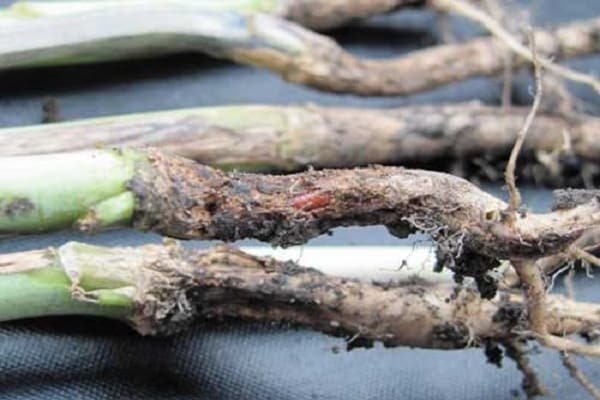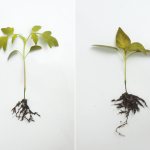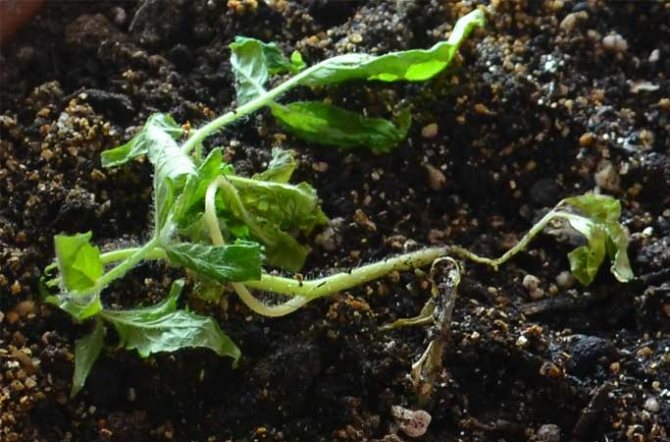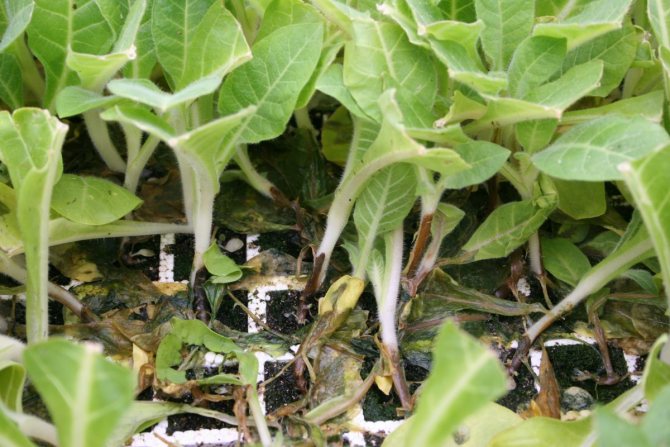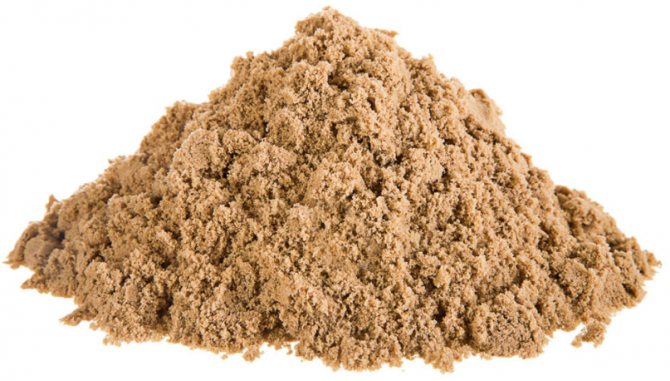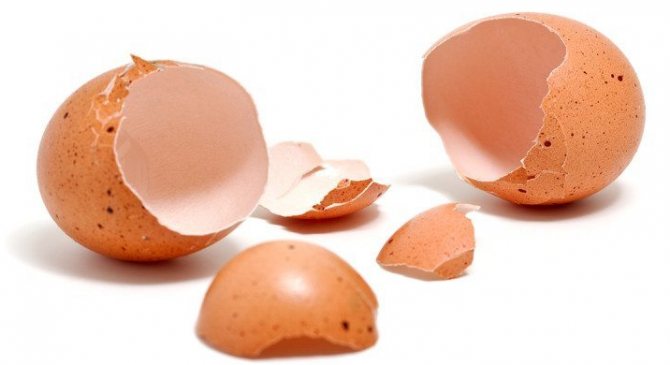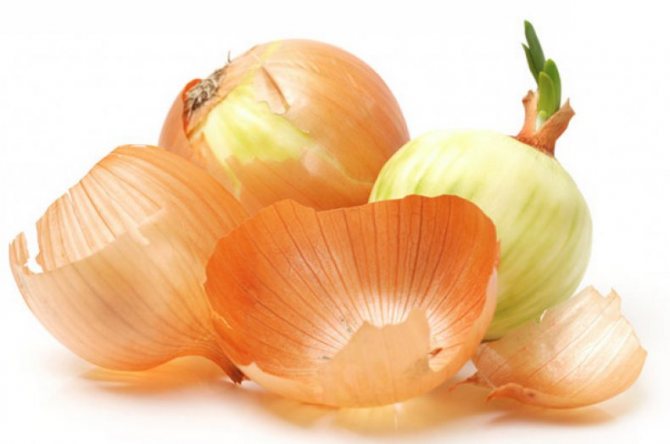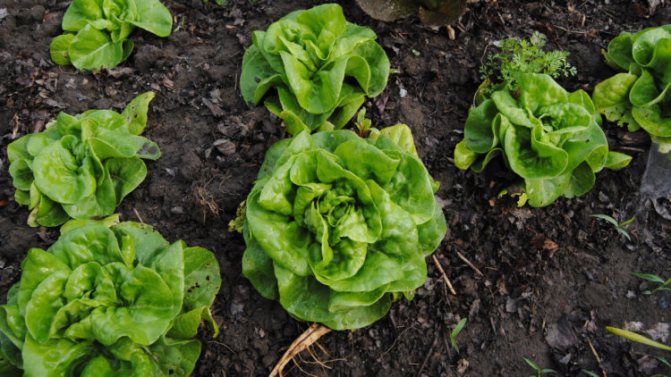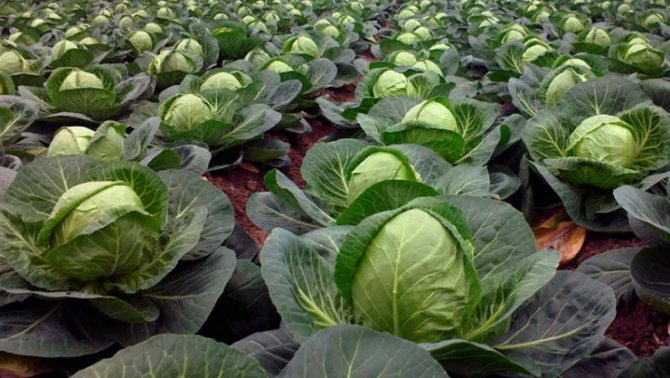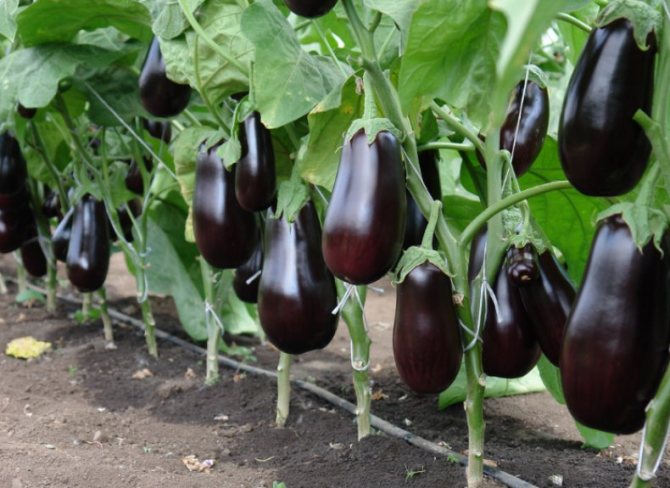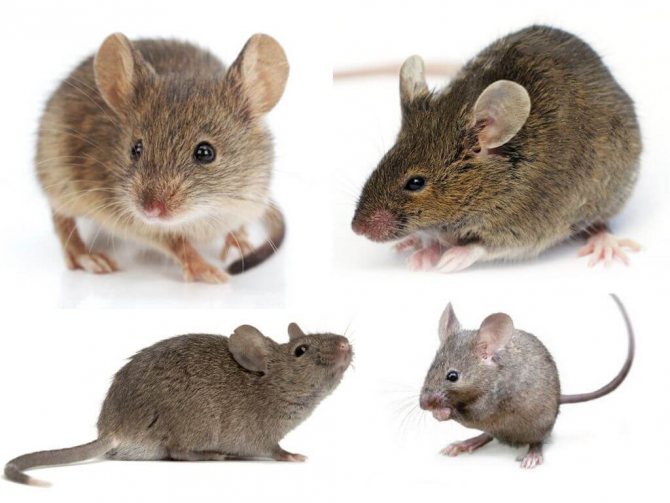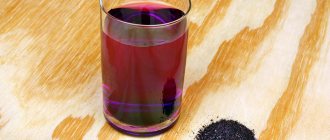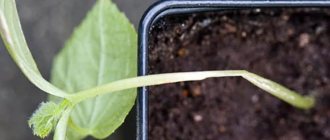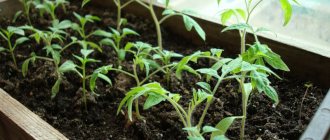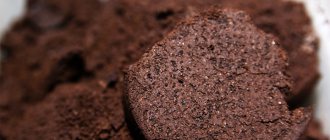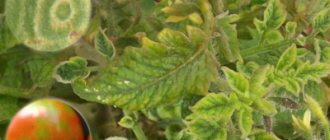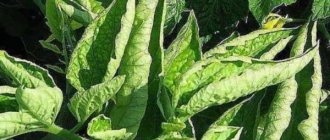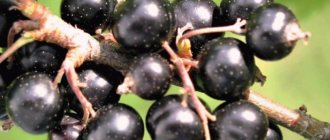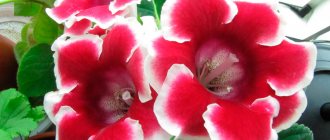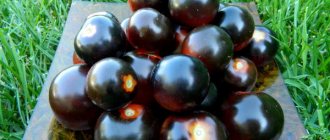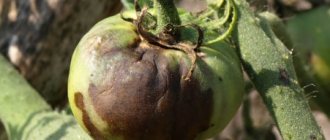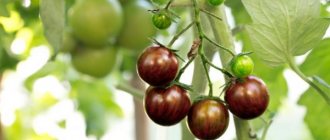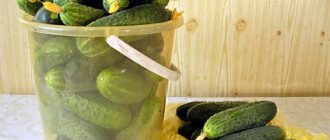Blackleg is the general name for a group of diseases with similar symptoms. The causative agents are two groups of phytopathogenic microorganisms - the simplest fungi and bacteria. Less common is a viral infection that affects the root zone of the plant. The lesion looks like a dry ulcer at the bottom of the stem. The infection is usually found on the seed coat. If a flower grows from such a seed, its shoots will be deformed, leaves and flowers twisted. Viral diseases (viral curl) are not cured. The plant, together with the pot, must be destroyed. If there is seed left, it should be destroyed.
What is black leg seedling?
Black leg - this is how gardeners who produce seedlings for personal plots or for sale usually call the root rot of the seedling neck. This is a fungal disease, ultimately, with active development, it causes lodging of seedlings and their complete death.
You can understand that your seedlings were struck by a black leg if you carefully examine the base of the seedling stalk, there, in the presence of this disease, you can see a change in the color of the tissue, that is, its blackening, and with the active development of this fungal disease - and decay of the plant tissue as once at the location of the root collar of the seedlings.
Usually, the black leg is most actively manifested from the moment when the sprouts of the hatched seeds just appear above the soil surface and until the moment the seedlings form two or three true leaves.
Description and symptoms
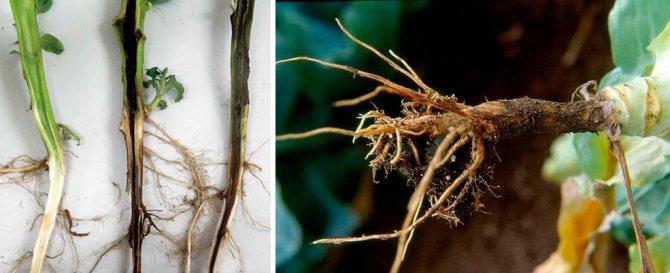
The first signs of the disease are yellowed leaves: they dry out at the edges and wrap up. Further, the stem is blackened at the base of the root. The stem becomes soft and loose, gradually thinning and drying out. It eventually breaks and the plant dies.
If you pull the plant out of the ground, you will see that the root system is damaged. It is from the root that the disease begins, gradually spreading upward.
Why does a black leg form and develop?
There are quite a few reasons for the formation and active development of such a disease as black leg of seedlings, it may be the soil deliberately infected with black leg fungus; excessively thickened crops, when moisture stagnates for a long time at the base of the seedlings, which, in combination with above-zero temperatures, gives the prerequisites for the development of the disease; excessive soil moisture, when moisture simply does not have time to evaporate and be used by plants; lack of fresh air - when the gardener, fearing a draft, does not ventilate the room at all; an excess amount of moisture in the soil, combined with an abundance of heat - these are ideal conditions for the rapid development of black leg seedlings; sharp changes in temperature - when the gardener, on the contrary, is overly keen on airing the room, which sometimes leads to temperature fluctuations of five or more degrees.
If one or more of these conditions take place, then sometimes only seven days are enough from the beginning of the development of the black leg to the complete blackening of the stems of the seedlings and the death of the seedlings. If you take such seedlings in your hands, you can feel with your fingers how the stems are very softened or, conversely, are characterized by increased fragility.
Mushrooms belonging to the genera Olpidium, Pythium, or Rhizoctonia cause the formation of a black leg. All these harmful fungi live in the top layer of the soil and eat dead plant tissue. At high humidity, fungi cease to feed on dead tissues and begin to feed on living tissues, or they can feed on both tissues at the same time. So, it is the root neck of the seedlings that is at risk during this period.
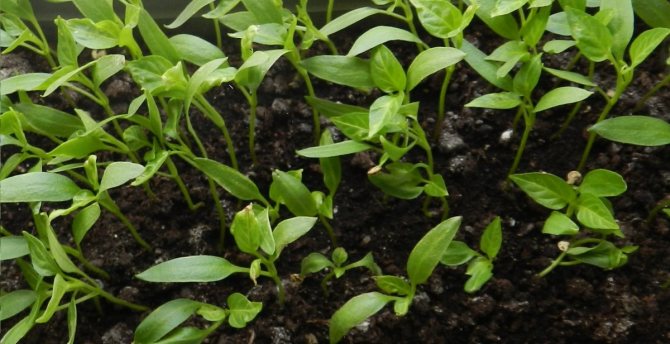

Thickened planting promotes the development of black leg on seedlings
Ring rot
Ring rot pathogens are less active than pathogens such as scab and black leg. Plants wither more slowly. The bacteria cause a gradual blockage of the vessels of the stem, first the lower leaves wither, then the middle, upper ones, and only later the stem. In the tubers of the new crop, bacteria also penetrate the stolons, causing the destruction of the vascular system. On the cut of the tuber, the rot looks like a ring, therefore it is called annular. First, the rot is yellow, then it takes on a brown color, later the tuber completely rots. When pressed in the area of the vascular ring, a light yellow mucous mass is released.
Sometimes bacteria penetrate the tubers without protection - through cracks, peeled off the skin. Unripe tubers are especially not resistant to damage, since their skin is fragile and easily peeled off. With such a lesion, in the places where bacteria enter the tubers, rot manifests itself in the form of yellow round spots, later on, pits form in place of the spots. This manifestation of the disease is called pitting rot.
Thus, the causative agent of ring (pit) rot remains in the seed tubers - in a latent state inside the tissues or on the surface of the tubers. Wet rot of potato tubers often appears during storage. The causative agents of the disease are bacteria commonly found in the soil. The defeat of tubers often occurs with excessive soil moisture. Bacteria penetrate into tubers through lentils, mechanical damage, lesions by late blight, dry rot, scab. Frozen and suffocated tubers are strongly affected. Further spread of the disease may occur in the repository. Wet rot of tubers causes softening of tissues, which subsequently turn into a slimy mass with an unpleasant odor. Even with a weak infection, the tubers are not suitable for storage. The development of rot is facilitated by excessive moisture and high temperature in the storage.
Preventive measures against black leg seedlings
To begin with, you always need to purchase high-quality seeds of modern varieties and reliable manufacturing companies with a written, not stamped date on the seed package. At the same time, try to give preference to the seeds of new varieties, but with a proven reputation, that is, reviews of which are already available, and you can compare this or that variety with a description from the manufacturer. And of course, try to acquire varieties that are either tolerant or immune to this disease.
If you are not sure of the quality of the seed, then before sowing, we strongly recommend holding them for a quarter of an hour in a light pink solution of potassium permanganate, and then rinse in running water. For the prevention and disposal of seeds from the fungus, if it is present on them, soaking the seeds in a solution of the Fitosporin preparation can help. You can soak the seeds for only a quarter of an hour, then rinse them in running water. Fitosporin can be used as a prevention of the appearance of a black leg and after picking seedlings, a day after picking seedlings, gently process the soil around the seedlings, trying not to fall on the leaves. The main thing during treatments is just to moisten the soil with a solution of the preparation, it is impossible to "fill" the seedlings with them.
Always observe the optimum sowing time for your seeds. For a particular variety, for a particular crop, the time of sowing seeds is always indicated on the package.Often, even a region is indicated there with reference to the sowing time, you should not ignore this information.
You should also not rush too much with sowing seeds, the room may not be warm enough, it may be snowing outside the window and it may be quite cold, and the cold from the window will only slow down the development of seedlings, make it difficult to evaporate excess moisture and allow the black leg to actively develop on your seedlings.
Provide enough lighting for your plants, depending on which crop you are growing. With a lack of light, the processes of photosynthesis slow down, the evaporation of moisture decreases, the immunity of plants decreases, as a result of all this, a black leg appears.
When growing seedlings, try not to use banal wooden boxes and plastic dishes, but peat tablets or peat-humus pots. These rather modern "devices" will allow you to avoid the appearance of a black leg or reduce the risk of its appearance several times. In addition, from peat-humus cups, for example, seedlings do not need to be removed - they can be planted directly into the soil of a greenhouse or into open ground, without damaging the root system at all. Such cups, although they cost a little more than plastic containers, will noticeably facilitate your work and keep the roots of the seedlings intact, and you will get an earlier harvest.
It is important to take care of the soil before placing the seeds there. For example, unfamiliar soil, in which you have no confidence, can be etched. The best option is a banal dark pink solution of potassium permanganate. It is prepared as follows: you need to dissolve three grams of potassium permanganate in a bucket of soft (that is, melt or rain) water. It also helps to disinfect the soil and rid it of the black leg, treatment with drugs such as Radiance, Renaissance or Baikal, that is, with EM drugs, or spill it with boiling water, destroying both bad (unfortunately, good) bacteria and fungi at once.
After the soil is disinfected in one way or another, let it "breathe" for three days, and then you can start sowing. If the soil is too "greasy" with an abundance of nutrients, then it will not be worse if on its surface you sprinkle a layer of river sand, previously washed in three waters, calcined and dried - it will retain excess moisture and prevent the fungus from developing intensively.
In the event that you are completely sure of the quality of the soil, then you can add a good drug to it, which many use to prevent black leg and other infections - Trichodermin. This drug is easy to obtain and it is not expensive.
After sowing, most gardeners cover a common container with seedlings with food or ordinary plastic wrap or glass. So, this can and even be done: a semblance of a greenhouse is created, however, every day the air in such a greenhouse needs to be ventilated by lifting the film and sprinkling the soil from the spray bottle if it starts to dry out in order to prevent the earthen coma from drying out.
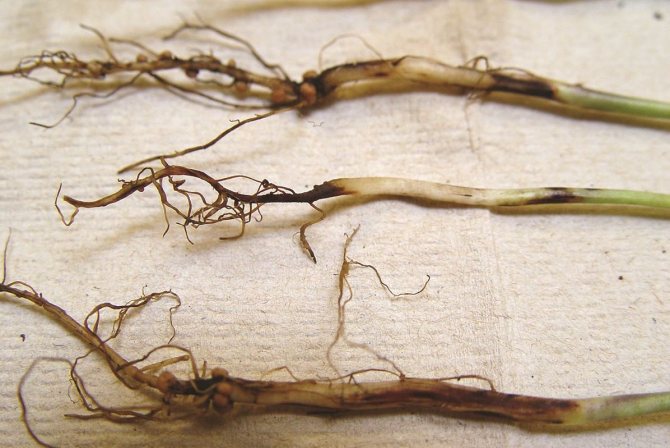

Roots and stems of seedlings affected by a black leg. <>
Control methods
There are several types of drugs to treat the disease. They can only be purchased at specialized stores. The choice of drug depends on the type of pathogen and the type of plant, therefore it is important to describe the symptoms to the seller in as much detail as possible.
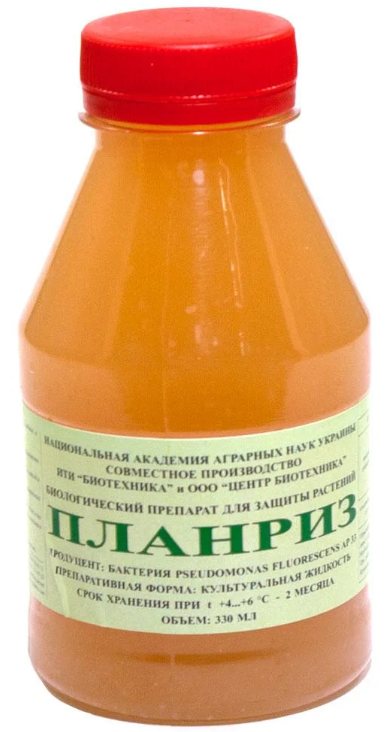

Planriz
Broad-spectrum antifungal drug. For 10 liters of water, take 100 ml of the drug. The resulting solution is watered at the root of the plant and sprayed with the leaves. It is also recommended to soak seeds for seedlings in the solution (50 ml of the drug is taken per 1 liter).
Trichocin
Antifungal drug in insoluble tablets. It is necessary to crush one tablet and mix it with 400 g of soil, mix thoroughly, pour over water and leave for 5-7 days. If the lesion of the black leg is too severe, then the dose can be increased by 2-3 times.The active ingredient in tablets dissolves slowly in the soil and destroys all microorganisms. To make the process more active, it is necessary to loosen the soil every few days. You should also monitor the level of moisture - the soil should not be dry.
Fitolavin
It is mainly used to treat the ground part of potatoes. It is enough to spray the tops once in dry weather. The drug works during the day. After 2-3 days, the procedure should be repeated. It is important not to water the plantings at this time, so as not to wash off the preparation. Spraying is useless in rainy weather.
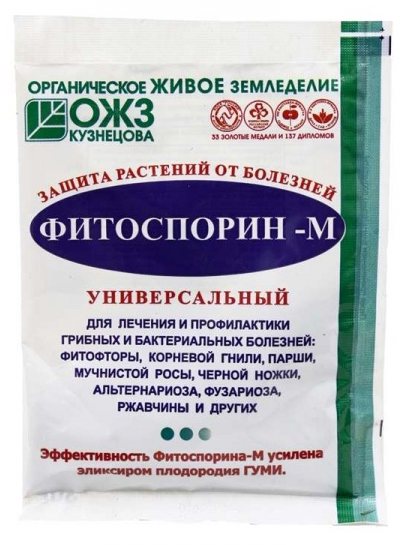

Fitosporin-M
Suitable for indoor and outdoor use. For 1 liter of water, take 20 g of the drug, mix and spray the affected areas of the plant. You can soak potato tubers, gladioli and seeds for seedlings in a solution. This will reduce the likelihood of developing the disease.
Prevecour Energy
A potent drug. It is used only outdoors due to its toxicity. To prepare the solution, 2 ml of the drug per 1 liter of water is enough. It is necessary to spray the entire ground part of the plant. Usually one spray is enough. It is advisable to carry out the procedure with rubber gloves and a protective mask.
Fentiuram
Sold in powder form. It is diluted with water (20 g of powder is taken for 1 liter) and the seeds and tubers of plants are soaked in it for 24 hours. All pathogenic microflora is destroyed.
Fundazol
One of the most toxic drugs. It is necessary to prepare a solution (10 g per 0.5 l) and spray the affected areas with it. For dressing tubers and seeds of water, take 2 times more of the drug. It can only be used outdoors no more than once a month, as the solution is dangerous for plants as well. It is not recommended to use it during the flowering period, so as not to destroy the ovaries.


Baktofit
An antibacterial agent that is often used to prevent blackleg. For 1 liter, take 2-3 ml of the drug. The solution is sprayed on the leaves and watered under the root. You can also soak tubers and seeds in the solution (1 ml per 0.5 l of water).


Colloidal sulfur
Means for soil disinfection. Prepare a solution (2 g per 1 liter of water) and water the soil along with the plants. For a person, the tool is practically harmless. Fruit harvesting is possible 2-3 days after the last sulfur application to the plant.
TMTD
Means for dressing seeds and tubers. Sold in cans of 10 liters. The seeds are soaked in the solution for several hours 2-15 days before sowing.
Fighting black leg seedlings
If the black leg was noticed late and about a third of the seedlings are already infected with the infection, then the first thing to do is to prevent the spread of the infection, that is, remove the sick and burn them. Ideally, the remaining seedlings should be transplanted into new, clean soil, but if they are very small, then the places where the diseased seedlings grew with a pink solution of potassium permanganate can be treated.
All other plants without signs of infection must be treated with Fitosporin. At the same time, watering the finished solution is necessary exclusively under the root system of still healthy plants. If the disease has overtaken the seedlings, when the plants have already managed to form a couple of true leaves, then the Fitosporin solution can be used to treat all the plants of the seedlings as a whole, falling on the leaves, and on the stems, and on the ground.
If this drug is not at your disposal, then you can try to use copper-based drugs to combat the black leg, for example, Bordeaux liquid (1% solution is enough), copper oxychloride (1.5% solution), copper sulfate (1% solution). If none of this is available or the use of these drugs is unacceptable for you, then you can use a weak (crimson) solution of potassium permanganate and spray the soil around healthy seedlings after removing all diseased ones.
With a strong infection, when the black leg has affected more than half of the seedling plants and there is nowhere to transplant them, and there is nowhere to take fresh soil, you can sprinkle the soil with a mixture of one teaspoon of copper sulfate and one glass of wood ash crushed into dust, or better - soot, this is the norm for square meter of crops.
In the event that the defeat is strong and you have at your disposal both the place and the soil to transplant healthy seedlings there, then it is better to unpack them in separate cups, using exclusively disinfected soil to fill them. You can disinfect the soil using the methods described above, or take the required amount of soil and calcine it in the oven at 100 degrees for a quarter of an hour. But even after that, it is still advisable to shed the soil with Fitosporin or Baktofit. After planting plants in such soil, they, as a rule, do not get sick, but you can overcome a little and a week after their growth in a new place, rearrange the cups in a room with a temperature a couple of degrees below the one where they stood earlier.
"Diagnostics" of the disease
The black leg affects pepper seedlings at any age, both at the stage of cotyledons and after spawning, when the seedlings already have true leaves. It all depends on what phytopathogens are in the soil.
When affected by saprophytes (Phytium, Rhizoctonia, Phoma), the course of the disease is usually sluggish. The stem becomes dark green, gray or black in color.
First, the mushrooms infect the root of the plant, and then move to the aerial part. Because of this feature, saprophytic fungi are often called root-eaters.
In diseased plants, when removed from the soil, an almost complete absence of roots is found. First of all, pathogens affect weakened seedlings after a pick. Treatment consists in transplanting peppers into disinfected soil with wood ash.
Fusarium penetrates the tissues of seedlings in the area of the hypocotal knee. At this point, the stem withers and twists, acquiring a dark color. The affected part looks like a black constriction (see photo).
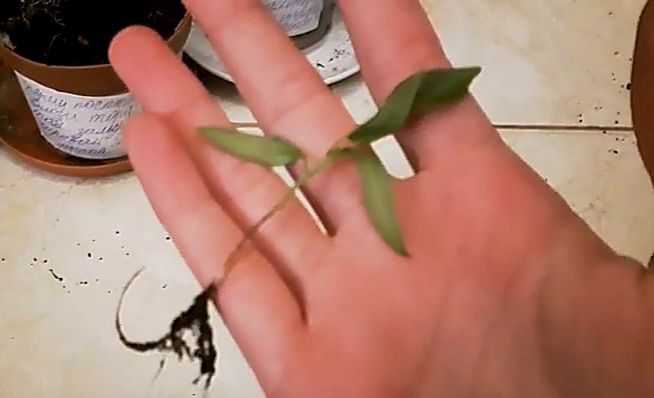

To diagnose the disease, you need to try to pull the infected seedling out of the soil. When infected with fusarians, the plant does not stretch out easily, since the root system is intact, and does not break in the constriction area, because the infected stem becomes more rigid. If you cut it, then at the cut site you can find a black ring, which is nothing more than the mycelium of Fusarium.
We fight with a black leg with folk remedies
In conclusion, we will give examples of folk remedies for fighting the black leg. In fact, there are a lot of such means of struggle, but we have chosen the most effective ones.
At the first place - dusting the soil with wood ash or wood soot with a layer of just a few millimeters. Gardeners claim that the black leg does not develop on such soil, and the seedlings grow beautifully.
In second place it is worth watering the seedlings with a solution of ordinary baking soda - you only need one teaspoon of soda per glass of water, this volume is enough for a square meter of the seedling box, and you need to water it once a week.
On the third place - Soaking the seeds in Epin's solution, while the ampoule is dissolved in a liter of water and the seeds are soaked in it for the whole night, gardeners claim that such seedlings are not affected by a black leg.
So, it is clear that a black leg can be dealt with both through competent preventive measures, that is, to prevent its appearance at all, and with the help of various means of dealing with it. But do not think that this disease is not worth focusing on. The black leg is very dangerous and if you miss the moment of mass destruction of seedlings, it will be impossible to return the lost days, and the seedlings will only have to be thrown away, so be careful about this disease.
Blackleg protection measures - prevention and control
It is advisable to use comprehensive protection measures aimed at both phytopathogens (both fungal and bacterial)
Prevention measures
1.Use only clean, disinfected containers (pots, pallets, boxes) for growing seedlings.
2. It is imperative to treat seed material with fungicides.
3. Avoid excessive soil moisture - reduce the number of seedlings irrigated, ensure the availability of drainage, etc.
4. Prevent soil acidification by regular loosening and / or adding agrovermiculite to the seedling soil.
5. Observe the optimal time for sowing seeds, taking into account the grade, geographic referencing, etc.
6. Pale, elongated seedlings are most often damaged by the "black leg", therefore it is recommended to use root stimulants "Kornevin", "Root-Super", "Kornestim", etc., providing improved rooting and painless transplantation / picking of seedlings.
7. It is best to use special "clean" peat-manure or vermicompost seedling soils tested, "North-Western peat, etc.), which contain all the components and trace elements in the required proportions. It is strictly forbidden to use forest, greenhouse or other untreated soil. Beware of buying primer from an unknown manufacturer in cheap stores. No need to engage in "amateur performance" - mix something, or add something.
8. If you cannot get rid of the desire to add something or mix, then it is recommended to use only humus aged for at least 2 years, and when adding peat to the seedling soil, observe the exact dosage, excessive peat content is not permissible.
9. Avoid thickening of plantings, timely thin out the seedlings and dive seedlings.
10. When the first signs of wilting appear, as well as fortifying agents, use drugs - stimulants "Epin", "Krepysh", "Zircon", "Immunocytofit", Previkur Energy etc.
11. Excessive acidity of the soil can be neutralized by adding ash.
12. To carry out preventive treatments with biological products - "Trichodermin", "Fitosporin", "Fitolavin" or others. They contain bacteria or fungal spores that destroy pathogens at their level. Biological fungicides are used as a prophylactic agent, as well as for direct control of the "black foot".
13. To use the latest varieties and hybrids of plants, resistant to fungal, bacterial and viral infections, the science of breeding and biology does not stand still.
What is the causative agent of the disease?
It is a kind of bacteria that is stick-shaped. If the conditions suit them, they multiply very quickly. Uniting in colonies, they begin to infect plants. Many cultures are susceptible to this disease, so it does not experience a lack of nutrition.
The bacterium cannot overwinter in the soil on its own, so it looks for plant residues and tubers. Will survive the winter in the stem or root of weeds. With the onset of heat, it continues to reproduce. That is why it is recommended to remove all plant residues from the fields.
